Regulation of angiotensin II-induced neuromodulation by MARCKS in brain neurons
- PMID: 9660875
- PMCID: PMC2133039
- DOI: 10.1083/jcb.142.1.217
Regulation of angiotensin II-induced neuromodulation by MARCKS in brain neurons
Abstract
Angiotensin II (Ang II) exerts chronic stimulatory actions on tyrosine hydroxylase (TH), dopamine beta-hydroxylase (DbetaH), and the norepinephrine transporter (NET), in part, by influencing the transcription of their genes. These neuromodulatory actions of Ang II involve Ras-Raf-MAP kinase signal transduction pathways (Lu, D., H. Yang, and M.K. Raizada. 1997. J. Cell Biol. 135:1609-1617). In this study, we present evidence to demonstrate participation of another signaling pathway in these neuronal actions of Ang II. It involves activation of protein kinase C (PKC)beta subtype and phosphorylation and redistribution of myristoylated alanine-rich C kinase substrate (MARCKS) in neurites. Ang II caused a dramatic redistribution of MARCKS from neuronal varicosities to neurites. This was accompanied by a time-dependent stimulation of its phosphorylation, that was mediated by the angiotensin type 1 receptor subtype (AT1). Incubation of neurons with PKCbeta subtype specific antisense oligonucleotide (AON) significantly attenuated both redistribution and phosphorylation of MARCKS. Furthermore, depletion of MARCKS by MARCKS-AON treatment of neurons resulted in a significant decrease in Ang II-stimulated accumulation of TH and DbetaH immunoreactivities and [3H]NE uptake activity in synaptosomes. In contrast, mRNA levels of TH, DbetaH, and NET were not influenced by MARKS-AON treatment. MARCKS pep148-165, which contains PKC phosphorylation sites, inhibited Ang II stimulation of MARCKS phosphorylation and reduced the amount of TH, DbetaH, and [3H]NE uptake in neuronal synaptosomes. These observations demonstrate that phosphorylation of MARCKS by PKCbeta and its redistribution from varicosities to neurites is important in Ang II-induced synaptic accumulation of TH, DbetaH, and NE. They suggest that a coordinated stimulation of transcription of TH, DbetaH, and NET, mediated by Ras-Raf-MAP kinase followed by their transport mediated by PKCbeta-MARCKS pathway are key in persistent stimulation of Ang II's neuromodulatory actions.
Figures
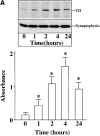






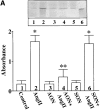


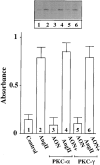



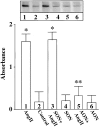
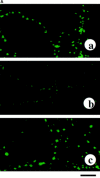

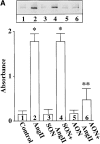



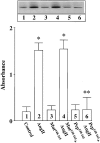
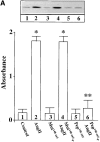


Similar articles
-
MAP kinase-independent signaling in angiotensin II regulation of neuromodulation in SHR neurons.Hypertension. 1998 Sep;32(3):473-81. doi: 10.1161/01.hyp.32.3.473. Hypertension. 1998. PMID: 9740613
-
Regulation of neuromodulatory actions of angiotensin II in the brain neurons by the Ras-dependent mitogen-activated protein kinase pathway.J Neurosci. 1996 Jul 1;16(13):4047-58. doi: 10.1523/JNEUROSCI.16-13-04047.1996. J Neurosci. 1996. PMID: 8753867 Free PMC article.
-
Obligatory role of protein kinase Cbeta and MARCKS in vesicular trafficking in living neurons.Hypertension. 2002 Feb;39(2 Pt 2):567-72. doi: 10.1161/hy0202.103052. Hypertension. 2002. PMID: 11882609
-
New aspects of neurotransmitter release and exocytosis: Rho-kinase-dependent myristoylated alanine-rich C-kinase substrate phosphorylation and regulation of neurofilament structure in neuronal cells.J Pharmacol Sci. 2003 Sep;93(1):35-40. doi: 10.1254/jphs.93.35. J Pharmacol Sci. 2003. PMID: 14501149 Review.
-
Calmodulin and protein kinase C cross-talk: the MARCKS protein is an actin filament and plasma membrane cross-linking protein regulated by protein kinase C phosphorylation and by calmodulin.Ciba Found Symp. 1992;164:145-54; discussion 154-61. doi: 10.1002/9780470514207.ch10. Ciba Found Symp. 1992. PMID: 1395931 Review.
Cited by
-
Shift to an involvement of phosphatidylinositol 3-kinase in angiotensin II actions on nucleus tractus solitarii neurons of the spontaneously hypertensive rat.Circ Res. 2009 Dec 4;105(12):1248-55. doi: 10.1161/CIRCRESAHA.109.208926. Epub 2009 Oct 22. Circ Res. 2009. PMID: 19850939 Free PMC article.
-
The Combination of Astragalus membranaceus and Ligustrazine Protects Against Thrombolysis-Induced Hemorrhagic Transformation Through PKCδ/Marcks Pathway in Cerebral Ischemia Rats.Cell Transplant. 2020 Jan-Dec;29:963689720946020. doi: 10.1177/0963689720946020. Cell Transplant. 2020. PMID: 32749163 Free PMC article.
-
Protein kinase Cβ is a modulator of the dopamine D2 autoreceptor-activated trafficking of the dopamine transporter.J Neurochem. 2013 Jun;125(5):663-72. doi: 10.1111/jnc.12229. Epub 2013 Mar 18. J Neurochem. 2013. PMID: 23458603 Free PMC article.
-
Effect of reduced myristoylated alanine-rich C kinase substrate expression on hippocampal mossy fiber development and spatial learning in mutant mice: transgenic rescue and interactions with gene background.Proc Natl Acad Sci U S A. 1998 Nov 24;95(24):14517-22. doi: 10.1073/pnas.95.24.14517. Proc Natl Acad Sci U S A. 1998. PMID: 9826732 Free PMC article.
-
Construction and analysis of the protein-protein interaction networks based on gene expression profiles of Parkinson's disease.PLoS One. 2014 Aug 29;9(8):e103047. doi: 10.1371/journal.pone.0103047. eCollection 2014. PLoS One. 2014. PMID: 25170921 Free PMC article.
References
-
- Aderem A. The MARCKS family of protein kinase-C substrates. Biochem Soc Trans. 1995;23:587–591. - PubMed
-
- Ahmad F, Li PM, Meyerovitch J, Goldstein BJ. Osmotic loading of neutralizing antibodies demonstrates a role for protein-tyrosine phosphatase 1B in negative regulation of the insulin action pathway. J Biol Chem. 1995;270:20503–20508. - PubMed
-
- Amess B, Manjarrez-Hernandex HA, Howell SA, Learmonth M, Aitken A. Multisite phosphorylation of the 80 kDa (MARCKS) protein kinase C substrate in C3H/10T1/Z fibroblasts, quantitative analysis of individual sites by solid-phase microsequencing. FEBS (Fed Eur Biochem Soc) Lett. 1992;297:285–291. - PubMed
MeSH terms
Substances
LinkOut - more resources
Full Text Sources
Other Literature Sources
Research Materials
Miscellaneous

